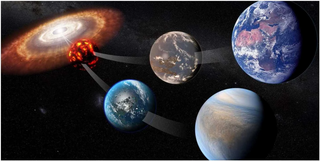
The Drake equation is a probabilistic argument used to estimate the number of active, communicative extraterrestrial civilizations in the Milky Way Galaxy.

The Fermi paradox is the discrepancy between the lack of conclusive evidence of advanced extraterrestrial life and the apparently high likelihood of its existence. As a 2015 article put it, "If life is so easy, someone from somewhere must have come calling by now."

The Galactic Center is the rotational center and the barycenter of the Milky Way. Its central massive object is a supermassive black hole of about 4 million solar masses, which is called Sagittarius A*, a compact radio source which is almost exactly at the galactic rotational center. The Galactic Center is approximately 8 kiloparsecs (26,000 ly) away from Earth in the direction of the constellations Sagittarius, Ophiuchus, and Scorpius, where the Milky Way appears brightest, visually close to the Butterfly Cluster (M6) or the star Shaula, south to the Pipe Nebula.
The concept of self-replicating spacecraft, as envisioned by mathematician John von Neumann, has been described by futurists and has been discussed across a wide breadth of hard science fiction novels and stories. Self-replicating probes are sometimes referred to as von Neumann probes. Self-replicating spacecraft would in some ways either mimic or echo the features of living organisms or viruses.

In planetary astronomy and astrobiology, the Rare Earth hypothesis argues that the origin of life and the evolution of biological complexity, such as sexually reproducing, multicellular organisms on Earth, and subsequently human intelligence, required an improbable combination of astrophysical and geological events and circumstances. According to the hypothesis, complex extraterrestrial life is an improbable phenomenon and likely to be rare throughout the universe as a whole. The term "Rare Earth" originates from Rare Earth: Why Complex Life Is Uncommon in the Universe (2000), a book by Peter Ward, a geologist and paleontologist, and Donald E. Brownlee, an astronomer and astrobiologist, both faculty members at the University of Washington.
The zoo hypothesis speculates on the assumed behavior and existence of technologically advanced extraterrestrial life and the reasons they refrain from contacting Earth. It is one of many theoretical explanations for the Fermi paradox. The hypothesis states that alien life intentionally avoids communication with Earth to allow for natural evolution and sociocultural development, and avoiding interplanetary contamination, similar to people observing animals at a zoo. The hypothesis seeks to explain the apparent absence of extraterrestrial life despite its generally accepted plausibility and hence the reasonable expectation of its existence. A variant on the zoo hypothesis suggested by the former MIT Haystack Observatory scientist John Allen Ball is the "laboratory" hypothesis, in which humanity is being subjected to experiments, with Earth serving as a giant laboratory.
The Great Filter is the idea that, in the development of life from the earliest stages of abiogenesis to reaching the highest levels of development on the Kardashev scale, there is a barrier to development that makes detectable extraterrestrial life exceedingly rare. The Great Filter is one possible resolution of the Fermi paradox.

Intergalactic travel is the hypothetical crewed or uncrewed travel between galaxies. Due to the enormous distances between the Milky Way and even its closest neighbors—tens of thousands to millions of light-years—any such venture would be far more technologically and financially demanding than even interstellar travel. Intergalactic distances are roughly a hundred-thousandfold greater than their interstellar counterparts.

The Milky Way is the galaxy that includes the Solar System, with the name describing the galaxy's appearance from Earth: a hazy band of light seen in the night sky formed from stars that cannot be individually distinguished by the naked eye.

Planetary habitability is the measure of a planet's or a natural satellite's potential to develop and maintain environments hospitable to life. Life may be generated directly on a planet or satellite endogenously or be transferred to it from another body, through a hypothetical process known as panspermia. Environments do not need to contain life to be considered habitable nor are accepted habitable zones (HZ) the only areas in which life might arise.

An Earth analog, also called an Earth analogue, Earth twin, or second Earth, is a planet or moon with environmental conditions similar to those found on Earth. The term Earth-like planet is also used, but this term may refer to any terrestrial planet.
The planetarium hypothesis, conceived in 2001 by Stephen Baxter, attempts to provide a solution to the Fermi paradox by holding that our astronomical observations represent an illusion, created by a Type III civilization capable of manipulating matter and energy on galactic scales. He postulates that we do not see evidence of extraterrestrial life because the universe has been engineered so that it appears empty of other life.

The Eerie Silence: Renewing Our Search for Alien Intelligence is a 2010 popular science book by Paul Davies, chair of the SETI: Post-Detection Science and Technology Taskgroup of the International Academy of Astronautics. The Eerie Silence explores the possibilities of intelligent extraterrestrial life, and its potential consequences.

In astrobiology and planetary astrophysics, the galactic habitable zone is the region of a galaxy in which life might most likely develop. The concept of a galactic habitable zone analyzes various factors, such as metallicity and the rate and density of major catastrophes such as supernovae, and uses these to calculate which regions of a galaxy are more likely to form terrestrial planets, initially develop simple life, and provide a suitable environment for this life to evolve and advance. According to research published in August 2015, very large galaxies may favor the birth and development of habitable planets more than smaller galaxies such as the Milky Way. In the case of the Milky Way, its galactic habitable zone is commonly believed to be an annulus with an outer radius of about 10 kiloparsecs (33,000 ly) and an inner radius close to the Galactic Center.

Rare Earth: Why Complex Life Is Uncommon in the Universe is a 2000 popular science book about xenobiology by Peter Ward, a geologist and evolutionary biologist, and Donald E. Brownlee, a cosmologist and astrobiologist. The book is the origin of the term 'Rare Earth Hypothesis' which denotes the central claim of the book: that complex life is rare in the universe.
Milan M. Ćirković is a Serbian astronomer, astrophysicist, philosopher and science book author. He has worked in the fields of astrobiology, global catastrophic risks and future of humanity where he also co-authored with Nick Bostrom. A focus of his work is the Fermi Paradox for which he has critically discussed existing and also proposed novel solutions.

The following outline is provided as an overview of and topical guide to extraterrestrial life:
The Berserker hypothesis, also known as the deadly probes scenario, is the idea that humans have not yet detected intelligent alien life in the universe because it has been systematically destroyed by a series of lethal Von Neumann probes. The hypothesis is named after the Berserker series of novels (1963–2005) written by Fred Saberhagen.
The Hart–Tipler conjecture is the idea that an absence of detectable Von Neumann probes is contrapositive evidence that no intelligent life exists outside of the Solar System. This idea was first proposed in opposition to the Drake equation in a 1975 paper by Michael H. Hart titled "Explanation for the Absence of Extraterrestrials on Earth". Assuming that the probes traveled at 1/10 the speed of light and that no time was lost in building new ships upon arriving at the destination, Hart surmised that a wave of Von Neumann probes could cross the galaxy in approximately 650,000 years, a comparatively minimal span of time relative to the estimated age of the universe at 13.7 billion years. Hart’s argument was extended by cosmologist Frank Tipler in his 1981 paper entitled ‘Extraterrestrial intelligent beings do not exist’.
The firstborn hypothesis is a proposed solution to the Fermi paradox which states that no extraterrestrial intelligent life has been discovered because humanity is the first form of intelligent life in the universe.










